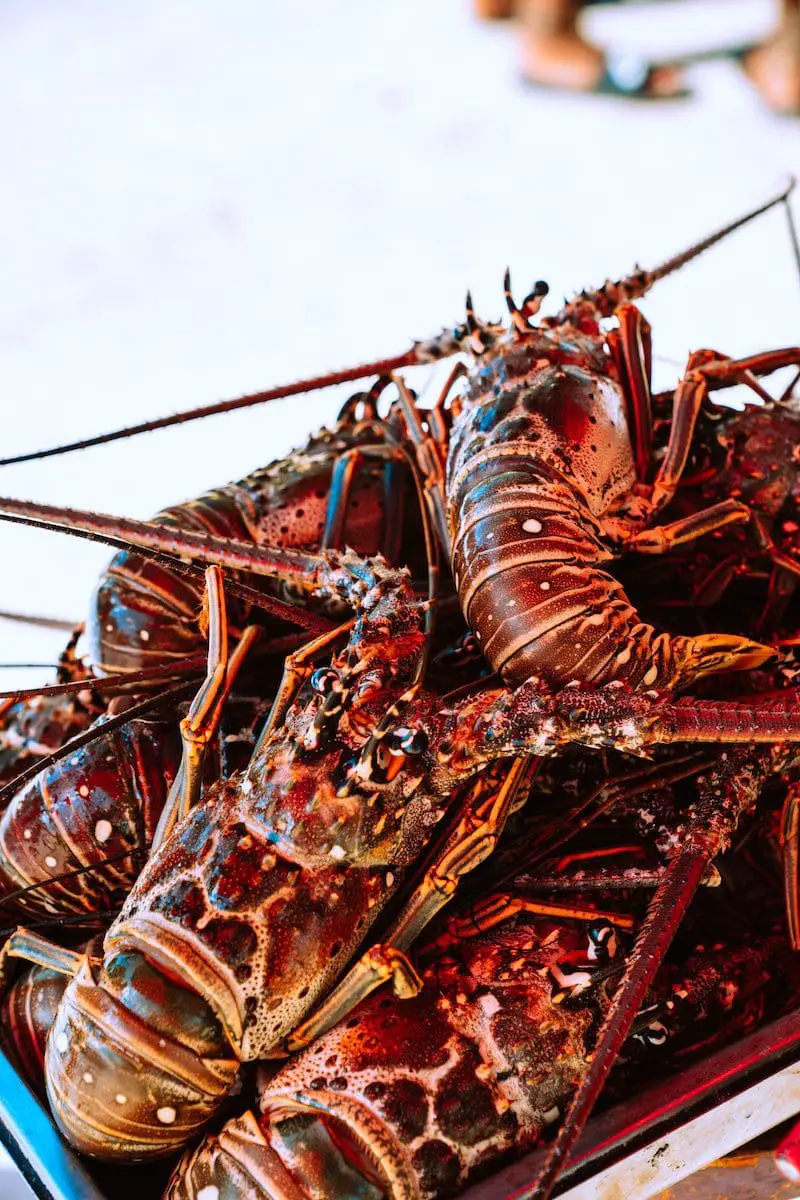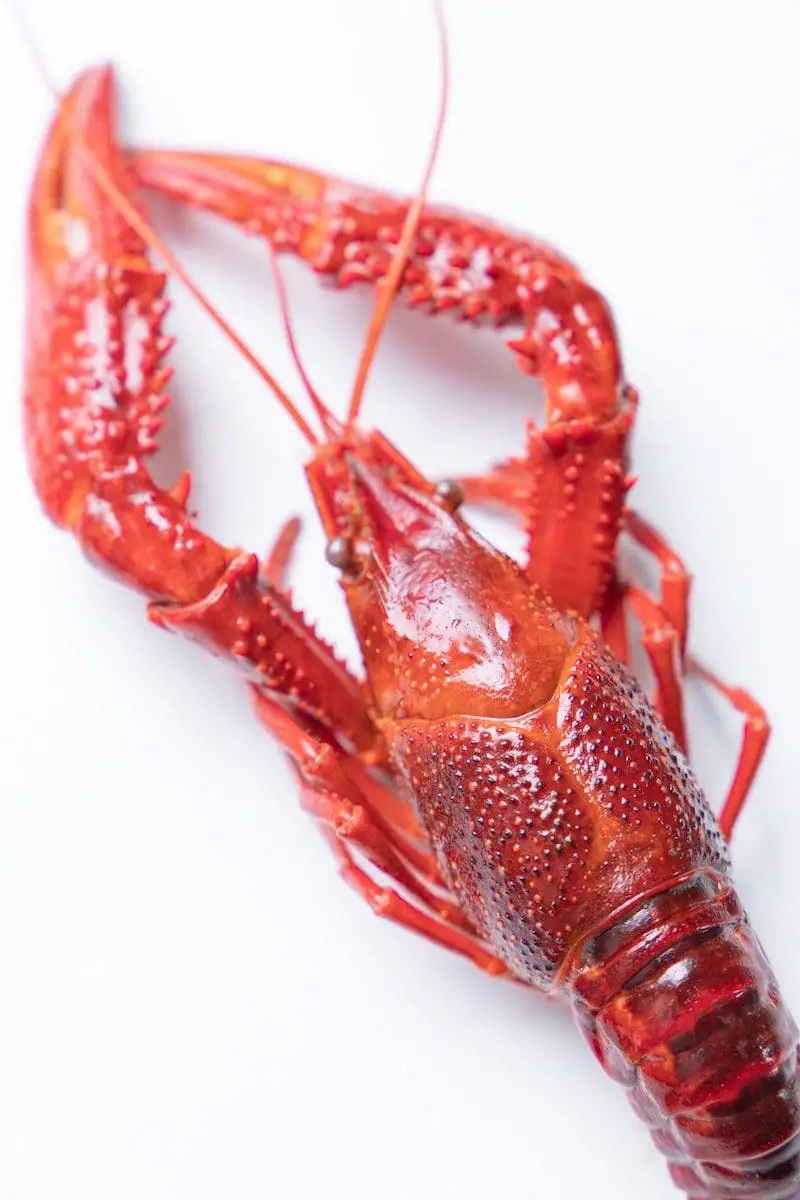People very commonly differentiate lobster and Crayfishe, and people find them very similar when looked at by the naked eye. However, that is not the case.
The differences between Lobsters and Crayfish are not limited to their select cooking styles. It goes way beyond; they both are completely different sets of animals and belong to different genetic families.
Key Takeaways
- Lobsters are marine crustaceans with a hard exoskeleton found in saltwater environments; crayfish are freshwater crustaceans with a hard exoskeleton found in streams, rivers, and ponds.
- Lobsters are larger, with a spiny exterior and two large claws; crayfish are smaller, with a smooth exterior and two smaller claws.
- Lobsters are considered a delicacy and used in various dishes, including lobster bisque and lobster rolls; crayfish are used in Cajun and Creole cuisine and are a popular food source for many animals.
Lobster vs. Crayfish
Lobsters are larger with longer bodies and claws. They are highly valued for their meat and are consumed as a delicacy. Lobsters live in saltwater environments. Crayfish are smaller and have shorter claws. They are used as food and bait for fishing. Crayfish live in freshwater environments. Lobsters have a hard exoskeleton, while crayfish have a soft one.

For the most part, lobsters are bigger than crawfish and can grow up to more than 20 inches. When lobsters are gathered for food, they are, in any event, eight inches in length.
Lobsters favor little sea creatures, and at times, they become scavengers. The squat lobster’s flavor and surface are like shrimp’s, except if something else, crayfish and lobster’s taste and surface are equivalent.
Lobster belongs to the Palinuridae family, while Crayfish belongs to Canbaridae, Astacidae, and Parastacidae. Lobsters are found in North America, while Crayfish are found in Europe.
This is a reason that Europeans sometimes refer to Lobsters as Sea Crayfish.
Comparison Table
| Parameters of Comparison | Lobster | Crayfish |
|---|---|---|
| Family | Lobster belongs to the Palinuridae family | Crayfish belongs to Canbaridae, Astacidae and Parastacidae family |
| Geographical location | Lobsters mainly live in Europe | Crayfish mainly live in North America |
| Size | Lobsters are larger than crayfish | Crayfish are comparatively smaller. |
| Diet | Lobsters mainly eat small fishes, snails, and prawns | Crayfish mainly eat plants, worms, and insects. |
| Color | Lobsters are colorful | Crayfish have a greenish color |
| Habitat | Lobsters live in saltwater | Crayfish live in freshwater. |
| Claws | A lobster has two large pincers or claws | A crayfish do not have them. |
What are Lobsters?
Lobsters are a family of large marine crustaceans, the common name of marine decapod crustaceans. They have long bodies with muscular tails. They prefer to live in crevices or burrows which exist on the seafloor. They also have claws.
Lobsters belong to the Palinuridae family. They are mainly found in Europe and are comparatively larger than Crayfish. They live in saltwater which includes oceans and seas.
They are colorful and have a set of two large pincers or claws. They mainly eat small fishes, snails, and prawns. The true lobsters (Homaridae) have claws (chelae) on the first three pairs of legs, with very large claws on the first pair.
In the words of people who eat seafood, they are called sea crayfish. However, it must be noted that lobsters differ greatly from Crayfish. Both physically and genetically.
Genetically they belong to completely different families, while physically, they have many differences in appearance and style of living.

What is Crayfish?
Crayfish are freshwater Crustaceans. Appearance-wise, Crayfish has a joined head and thorax and a segmented body. Their head has a sharp snout, and their compound eyes are on movable stalks.
Their exoskeleton, or body covering, is thin but tough. Adult Crayfish can be about 3 inches long.
Adult Crayfish can be about 3 inches long. Crayfish belongs to Canbaridae, Astacidae, and, Parastacidae family. They are mainly found in North America and are comparatively smaller than Lobsters.
Crayfish live in freshwater and mainly eat plants, worms, and insects. Appearance-wise, they are green in color. They are invertebrates, i.e., they do not have a backbone. They defend against their attackers using their strong claws.
Many people confuse Crayfish and Lobsters and find them similar. People fond of eating seafood refer to Lobsters as sea crayfish. They do so because Lobsters live in seawater, while Crayfish live in freshwater.

Main Differences Between Lobsters and Crayfish
- Lobster belongs to the Palinuridae family, while Crayfish belongs to Canbaridae, Astacidae, and Parastacidae.
- Lobsters are found in North America, while Crayfish are found in Europe. This is a reason that Europeans sometimes refer to Lobsters as Sea Crayfish.
- Lobsters are large. Crayfish are comparatively smaller in size. This is why people in North America refer to Crayfish as mini Lobsters.
- Lobsters mainly eat small fishes, snails, and prawns, while Crayfish mainly eat plants, worms, and insects. This differentiation in eating habits is seen in their texture.
- Lobsters can be colorful, while Crayfish have a greenish color. Even after this differentiation in color, people confuse as they find them similar.
- Lobsters live in seawater, while Crayfish live in freshwater. This is another reason Europeans call Lobsters sea Crayfish.
- A lobster has two large pincers, while Crayfish does not possess them. However, the claws of Crayfish are strong enough to fight against an attacker.

- https://rupress.org/jgp/article-abstract/44/6/1089/30533
- https://www.journals.uchicago.edu/doi/abs/10.2307/1542217

This article was very enlightening! The highlighted differences between lobsters and crayfish were informative and important to note.
I have to agree. The article could have had a more in-depth analysis of the genetic differences between lobsters and crayfish.
I found some missing details about the differences between lobsters and crayfish, so I cannot consider this article comprehensive.
The article explained the differences between the two crustaceans beautifully.
Agree, the article is quite comprehensive with its explanations.
The point-by-point comparison was helpful in grasping the differences easily.
I find it slightly amusing that there’s a debate about the differences between lobsters and crayfish. The article adds clarity to the misconceptions.
I think the comparisons are a bit exaggerated, but an amusing read nonetheless.
I have to point out that the distinctions are essential for understanding the marine ecosystem.
I found myself laughing at the idea of mistaking lobsters and crayfish. This article is a much-needed clarification on the subject.
I agree, this is the kind of information that makes me glad to have an intellectual discussion.
I can’t help but feel that the entire comparison sounds exactly like its written – unnecessary.
As a marine biologist, it’s surprising to see how many people mistake lobsters for crayfish. The difference is evident once you dive into the subject matter. This article is great to clarify the differences between the two crustaceans.
I completely agree! The article is very informative and clearly breaks down the differences between the two.
I disagree, this explanation is unnecessary. Anyone who confuses lobsters and crayfish is probably not interested in learning more about the topic. Waste of time.
I think most people would be surprised by the actual size differences between lobsters and crayfish, I know I was! This article is fascinating.
I appreciate the article’s detailed comparisons, but we could have used more data for sure.
The article provides a clear and concise breakdown of the differences between lobsters and crayfish. An excellent piece to educate misconceptions.
Absolutely, this article offers a lot of information on the topic.
Yes, I think it serves as a great reference for those unfamiliar with crustaceans.
The distinctions mentioned in the article are quite interesting and important to note when studying marine life.
I’m not sure why such a fuss is made about this comparison. The information is irrelevant in the grand scheme.
I think the article achieves its purpose of clarifying the differences effectively.
I found the article to be a valuable source of information. It’s crucial to understand the distinctions between lobsters and crayfish.
I have to respectfully disagree. I find the distinctions somewhat trivial.
I could not agree more. The article does an excellent job in emphasizing these differences.
While I enjoyed reading the article, I still find the confusion between lobsters and crayfish a little amusing. The anatomical disparities are quite dramatic.
I get your point, but ultimately, the article’s purpose is to set the record straight.